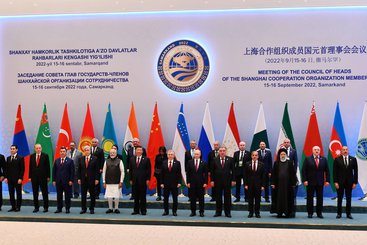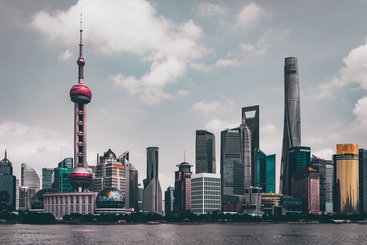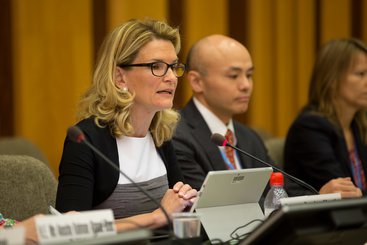Olena Borodyna: China’s saber-rattling on Taiwan ahead of COP27 heightens geopolitical risks to global energy transition and climate change ambitions
The need to tackle climate change globally has sharpened focus on delivering low-carbon energy transition globally. However, concurrent geopolitical risks can undermine this transition. China’s saber-rattling on Taiwan at the 20th Communist Party Congress, held just weeks ahead of COP27 is a good case in point.
Xi’s combative rhetoric on Taiwan prompted global speculation about the country’s shifting timeline for reunification with the self-ruling island and what the global response to that would look like. This rhetoric is neither surprising nor unprecedented. However, reunification is likely becoming a more pressing issue for the Party. As it moves towards fulfilling the second centenary goal of building China into a modern socialist country by 2049, it will want to ensure full control over what it considers an integral part of the country’s territory. In the context of the ongoing Russia-Ukraine war and increasingly fraught bilateral relations with the US, China’s rhetoric therefore escalates geopolitical risks to global low-carbon energy transition and climate change governance.
Russia’s invasion of Ukraine earlier this year shook global energy markets, highlighting the geopolitical risks linked to fossil fuel supply chains but also the risks of geopolitical shocks to energy transition. In response, some European countries, for example, turned to coal, if only temporarily, but also signalled their willingness to finance new gas infrastructure in Africa in sharp contrast to previous calls to end support for such projects.
The risks of conflict over Taiwan between China and the US to global energy transition will likely far exceed the impacts of the Russia-Ukraine war. Reducing fossil fuel dependencies, however, will not necessarily increase energy independence and reduce exposure to geopolitical risks. In the current geopolitical context, dependencies throughout renewable energy supply chains, expose countries to geopolitical risks which are difficult to minimise in the short to medium term.
What would these risks look like? Much depends on how the conflict, if one were to take place, would unfold – mutual financial and trade sanctions and severance of diplomatic relations, direct military confrontation, or a combination of the two, as well as which other countries get drawn into it. However, even if limited to sanctions and severe deterioration of diplomatic relations, it would create significant risks. Three are particularly pertinent.
First, bilateral talks between the two countries, and with them technological cooperation would become even more challenging if not impossible. While climate change is a universal issue, isolating it from broader geopolitical issues, particularly in the context of conflict, appears implausible. With the US playing a critical role in European security during Russia’s ongoing war with Ukraine, it would also expect the EU to support its response on Taiwan. As well as undermining the overall global message and cooperation on climate change and energy transition, halting technological cooperation may hinder research and development and timely scaling up of technologies that could be critical to low-carbon transition.
Second, any conflict between China and the US risks disruptions to low-carbon supply chains. China is critical supplier of solar panels and other components but also in mining and processing of critical transition minerals and rare earths. Both the US and the EU are now scrambling to diversify and reduce their dependencies on China across these supply chains. However, doing so may be difficult in the short to medium term. In case of conflict and trade restrictions with China, countries would scramble to replace the country in their supply chains risking disrupted transitions.
Third, financing for low-carbon infrastructure globally from China and the US would likely drop below the already modest levels. Ahead of the National Congress, China published a concept note for Global Energy Partnerships focused on catalysing global energy transition but a surge in financing for overseas renewables projects is yet to happen. At the same time, US climate financing falls short the levels it committed to. And while long-term systemic rivalry can bring financing opportunities for developing countries as China and the US compete for global influence, economic and political disruptions as a result of potential conflict over Taiwan, would further strain financing for transition.
As above examples illustrate, geopolitical risks will continue to loom large over the global energy transition and climate change governance. A conflict over Taiwan would disrupt the efforts to tackle a global threat that is climate change, but it is unclear that either China or the US would put it above its other interests.
Yunnan Chen: In a hostile external environment, China is subtly reshaping its approach to development and global governance
The overwhelmingly domestic focus of the national party congress offers few clues on China’s global south engagement going forward. Xi’s speech focused on the global north, the major powers, and was bullish on the hostile external environment facing China: the global south will be very much an afterthought.
While light in substance, what is clear from the report however is that development cooperation remains an important tool of legitimacy for China on the global stage—with some subtle shifts. Last decade was defined by the Belt and Road Initiative, framed as China’s contribution to global public goods. This time, the Belt and Road Initiative is only mentioned twice in this official report (compared to 5 times in the last 19th NPC in 2017), and in the context of China’s domestic growth and ‘opening up’ rather than outward cooperation, adding further weight to speculations of its retirement in China’s foreign policy. New initiatives—the Global Development Initiative and the Global Security Initiative—now occupy a more central position as part of ‘building world peace and development’ and are likely to be the primary mechanisms of cooperation with global south countries going forward.
Beyond the rhetoric, changes in personnel are key to watch. On the finance front, notably, the current head of the NDRC and Xi loyalist, He Lifeng, is tipped to take over the top economic advisory position, while the heads of the People’s Bank of China, Yi Gang, and banking regulator, Guo Shuqing, are likely to be replaced. As my colleague Linda points out, Chinese lending has been in stiff decline in the last five years. However, the rise of He—a member of the BRI leading group and a big supporter of infrastructure megaprojects during his NDRC tenure—along with a reshuffling in the central bank and banking regulator, may tip the balance away from the currently conservative approach, towards an expansion of credit to boost China’s economy—which puts an open question on how China’s overseas finance will evolve.
On global governance, Xi’s report reiterates China’s ambition for a greater voice, and a reshaping of a ‘fairer and more equitable’ global governance with ‘greater say in global affairs’ for developing and emerging economies. The speech is emphatic on China’s commitment to multilateralism and multilateral institutions, however, there is a curious lack of them. Aside from the UN, only the WTO and APEC are specifically mentioned in ‘making sure these [institutions] better play their roles’, while the traditional MDBs and other Bretton Woods institutions are notably absent. Instead, the Shanghai Cooperation Organisation (SCO), and BRICS feature prominently. All of this suggests the deepening of a Russia-aligned bloc, and a multilateralism increasingly framed in east-west rivalry. In an increasingly bitter and bifurcated global system, countries of the global south will need up their game to strategically navigate their relationship with China, or risk being squeezed out.
Linda Calabrese: The CPC consolidates China’s economic policy directions
The 20th National Congress of the Communist Party of China (CPC) concluded last week in Beijing. Those who watched the congress witnessed the consolidation of China’s economic policies under a few key areas.
In a speech summarising the achievements of the 19th National Congress and setting the direction for the 20th Congress, the CPC Secretary General Xi Jinping reiterated the importance of ‘high-quality development’, indicating that the CPC wants to continue to pursue productive economic development led by domestic demand, export and profitable investment, rather than growth fueled by non-productive investment in infrastructure and real estate.
Xi also emphasized the concept of ‘common prosperity’, which indicates the intention to reduce inequality. This has been a long-standing policy aimed at reducing inequality, particularly crucial in a country that has seen its Gini index (a widely used measure of income inequality) rising steadily compared to the 1970s, and is now higher than that of the UK. While there is scepticism about how common prosperity is formulated (as donations from profitable businesses and the wealthy, rather than as a form of redistribution to households), there is also a sense among commentators that the focus on redistribution may have become stronger. Xi Jinping referred to efforts to reduce country-wide inequalities between coastal and western provinces and between rural and urban areas.
Xi’s speech also emphasized the importance of strengthening science, technology, and innovation; and with that the need to increase human capital to bring China to the technological frontier. Here, trade tensions with the United States are particularly prominent. The Chinese government knows it is important to develop the domestic technology scene to avoid dependence on foreign actors. For this, the CPC is not only emphasizing human capital, but also bringing technocrats into the political field.
These directions are not new, but rather consolidate existing policies. They arrive at a particularly delicate time for the Chinese economy. GDP growth has slowed down in 2022, to the point that even the 5.5% GDP growth target set earlier this year by the government seems only possible in conjunction with massive (distortionary) stimuli. The causes for this slowdown are manifold, including China’s ‘zero Covid’ policy, which has stopped growth in its tracks in many parts of the country; and a battered real estate sector, propped up by unsustainable debt. To maintain China Covid-free, the CPC has chosen to sacrifice economic growth in the name of stability.
But the loss of economic growth can be destabilizing too. The combination of the zero Covid policy and changes in the labour market means that one in five young Chinese is unemployed. This is not equalizing or stabilizing, this is a dangerous situation, especially in a country that has enjoyed high levels of growth in the past four decades. While there are ways to normalize and adapt to slower growth, the alternatives can be difficult to navigate and even painful in the short term.
So what does that mean for the rest of the world, and in particular, for the low- and middle-income countries dealing with China? It’s not good. The International Monetary Fund defined China’s slowdown as a threat to the global economy, alongside inflationary pressures and Russia’s invasion of Ukraine.
It is not news that China’s lending by the two main policy banks has declined since 2016. With a slow-growing China, we do not expect this type of lending to grow in the coming years (although other forms of finance may be gaining space). Furthermore, sudden episodes of growth fuelled by China, such as the commodity boom of the early 2000s, are unlikely to occur in this economic climate, especially in the absence of additional stimuli. The pursuit of stability ahead of economic growth does not indicate any change in direction in the coming years. Overall, slower economic growth in China may be bad news for low- and middle-income countries.





